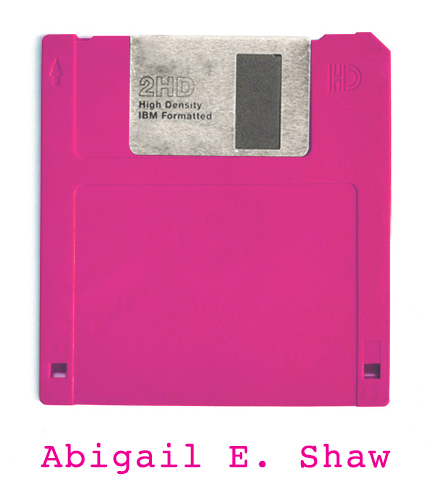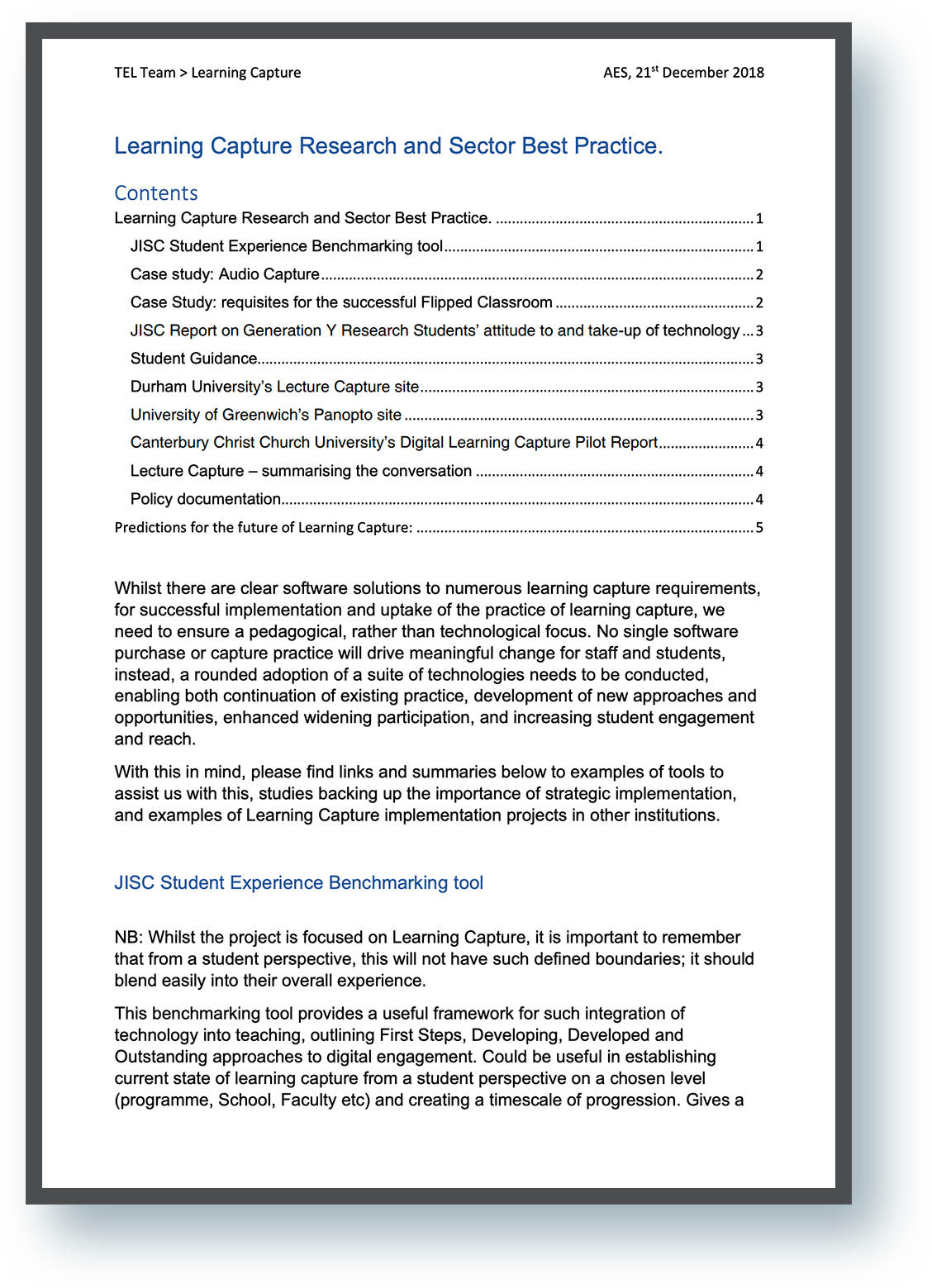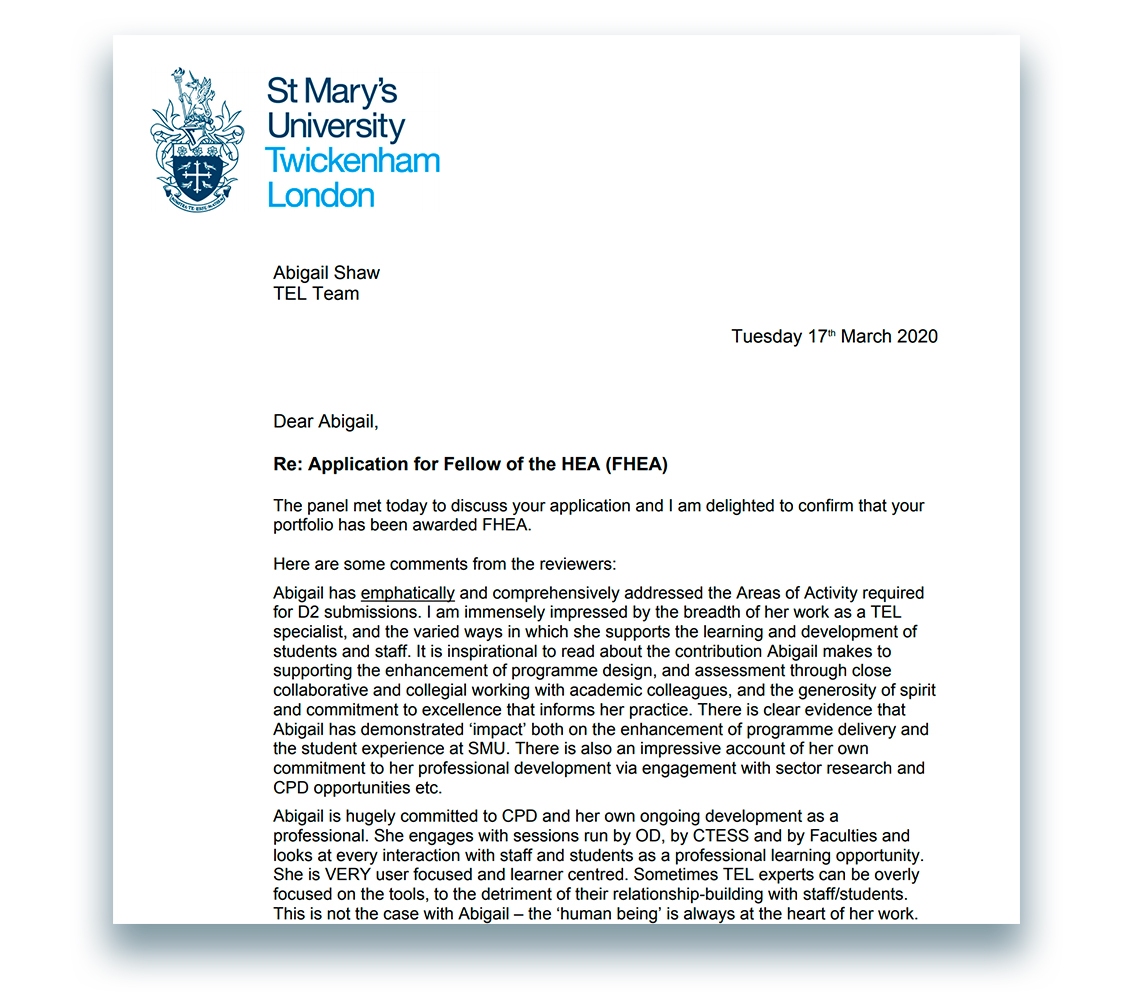
|
Core Area 4: Communication and working with others
In my CMALT portfolio (2020) I described my work with the Learning Capture project in my previous institution, which included defining concepts across project board, working group, and wider academic community, acting as a conduit for feedback both up and down the project, brokering support for the project in the first place, and encouraging engagement and feedback at every possible stage, including at a key event. As evidence, I included a paragraph outlining my contribution to the project from the Project Manager (1), two reports created to facilitate communication and understanding of Learning Capture both at my institution (2), and in the wider HE environment (3); and a selection of categorised feedback from the event (4). This project remains the largest institutional change I have significantly influenced, and, as the outcome of the project, and the impact of it would become all the more visible as Emergency Remote Teaching kicked in at our institution. In updating this section for my Senior CMALT application, I include an update regarding the deployment of the selected platform (Panopto) and reflections on the ways in which my participation in this project has continued to shape and influence my approach to projects in my current role. Description:Defining Learning Capture was an important step in aligning the understanding of the project with the nature of Learning Capture which would specifically appeal to the academics we work with. A previous Lecture Capture project was abandoned after strong resistance from academics and unions alike - this earlier incarnation had mandated lecture capture, and was highly centred around the recording of live lectures. Resistance included: concerns regarding content ownership, anxiety around being recorded, concerns regarding student safeguarding, and fears that attendance would be impacted. The original project sponsor, the Dean of Learning and Teaching, proposed this terminology shift to Learning Capture, in order to give the project a new stretch of life, allowing the university to respond to student requests, and to empower staff to pick and choose from the elements that appealed to them, and to their teaching styles. In the early stages of this project, there was significant concern that it would, once more, be met with strong resistance, so I was tasked by the Project Manager with creating a report on current practice and/or experience in other Higher Education institutions, as well as a document defining what the project means when it talks about Learning Capture. These documents were distributed to the Project Board, not all of whom were familiar with the conceptual shift the project was keen to have at its core, and also to the Working Group which was convened early on, bringing together representatives from services, staff and students. I spent a significant amount of time discussing the project's existence on an informal basis with academics, seeking to identify their various issues and resistance, and working to ensure that the project was continually orientating Learning Capture as an opt-in service. My colleague and I created a database of courses and staff members that we knew were utilising various forms of learning capture already at the university, and I presented case studies of these back to the Working Group; my colleague also took some of these to the Project Board. Our Chief Information Officer (CIO) was very keen to ensure the wider staff body was formally included and consulted, given the anxiety around the implementation and deployment of Learning Capture, and in light of this, set up a "Supplier Day", where sales reps from each of the six Learning Capture software solutions we were considering were invited to come and present at the university, and all members of staff were invited to attend and interact freely with them. I spent some time encouraging staff who were for, against and ambivalent to Learning Capture to come and have it presented to them, and to feel free to ask the suppliers themselves anything that interested or concerned them. We were thrilled to have over 50 members of staff attending across the 3-hour session, with representatives from the full spectrum of programmes offered. I ensured feedback could be swiftly and easily given, with post-it notes and whiteboards placed around and at the exit, and members of the working group were positioned centrally, clearly identified to their colleagues for further questioning. The CIO engaged significantly with many academics at the event, and spent some time discussing the possibilities for the development of the project with me on a one-to-one basis, which was a useful opportunity to gently ensure alignment of the project's goals at every level. We received a wide variety of extremely useful feedback, which was then taken to an early iteration of our TEL User Forum, and discussed with a further set of representatives. The Project Board then worked this feedback into the university's Requirements, submitted as part of the tender documentation. The project is currently out to tender, and I look forward to continuing my engagement through the deployment and support stages, and to integrating whichever software solution we choose as closely as possible with our VLE, enabling all manner of teaching, learning and assessment facilitation. 2022 Description Update:The eventual selection was Panopto, and, as I worked with the Panopto representative and central institutional teams to support the adoption and integration of the platform, to design training sessions and communications to staff, and to prepare communications for users at all levels, I found the process genuinely straightforwards, with our choices and intentions clear at all levels. This groundwork, the multiple opportunities for feedback and discussion, and the communication both internally, with the project team and senior leadership, was well in place, and it felt like we could truly progress our teaching, learning and assessment on the platform without needing to spend time on the (many, many) concerns that the modality had had 18 months before. When the platform suddenly became vital to the continuation of teaching and learning in March 2020, we were in the exceptionally fortunate position of just having completed the training and deployment of the platform, so all staff were, if not totally confident with it, at least had had a chance to test it, and to discuss with their colleagues the best ways to use it for their specific programmes. Similarly, we had already created all the student resources to support students in accessing both live-streamed, and recorded content. I was then able to focus my work on the ways in which teaching and learning were structured, as a direct result of the fact that our procurement and deployment processes were both carried out with thorough and considered communication to and from all stakeholders at all points. Reflection:I was pleased with the level of engagement and interest I was able to generate from staff who had almost universally been against Lecture Capture but who were almost all curious about and even excited by Learning Capture. I felt I was really able to capitalise on the strong, in-person working relationships I and my colleague had created by (as referenced in my Contextual Statement) being a visible and responsive team, and being sufficiently familiar with staff, their teaching styles and modules, to be able to discuss easily how Learning Capture might be something of value to them and to their specific students. My greatest challenge in supporting this project was continually aligning the hopes and expectations of the Project Board, the working group, and the wider academic community. I had conversations in almost every programme board I attended regarding the project, and reported back at each FADC committee meeting. One of the FADC meetings involved the presentation of a piece of policy which, it was felt, did not align with the presentation of the project to date, and I spent significant time discussing this at committee, recording and processing the feedback from staff present, and working with the Project Manager in order for them to communicate the concerns and alignment issues with the HR/legal team responsible for creating the policy. Were I to experience this same set of events again, I would have interacted with the policy prior to its presentation at committee, and recommended it was redrafted ahead of wider staff consultation, as, whilst the concerns expressed at its presentation were valid and the conversation was important, it repeated a stage that, I believed, had already been covered. Working on this project has been extremely valuable to me in the sense that it has demonstrated value in our team structure and behaviours to date. It has provided an exceptional opportunity to demonstrate to, in particular, our Chief Information Officer the strong professional relationships and broad institutional knowledge that I and my colleague possess. It has also been a lesson in the complexity of introducing institutional change, and in handling extremely valid concerns coming both from staff and from the senior management team. I worked hard to become a better conduit for these concerns, and became well-practised in the art of separating my own views and recommendations from those of the users or management whose views I needed to represent, sometimes simultaneously, in both formal and informal conversations. On a personal note, I was also able to tie in a great many things I'd learnt from engaging and organising visitors to the National Trust property I used to work at in order to get people to show up to the supplier event, and to give us feedback - I had learnt that there's no substitute for walking up to someone with a post-it note or clipboard and saying, "So, which aspect of this did you like best?" or similar. I was delighted to be able to provide the project with a decent amount of constructive feedback. In future I might use polling software, such as Vevox (which the university is currently piloting) to gather additional views and feedback, but I think I'd still have an analogue option as well - again, the more variety of medium, the greater the opportunity! Reflection 2022:As a Faculty Learning Technology Lead, having a model for leadership and representation of the technological and pedagogical potential for platforms has been vital. The process I undertook in the Learning Capture project has gone on to inform and underpin the ways in which I work in a variety of ways. This experience working with a Project Team who, as it transpired, were moving into Agile methodology in 2020, also served me well, as I came to understand the purpose of sprints and stand-ups, and to know when to feed into the project, and the most useful ways of doing so. I now work across areas that work with Agile, and those that don't, so being able to collaborate with others productively regardless of their team methodology is a skill I appreciate having developed. Further, this project also showed me the importance of having as much representation and academic ownership of platforms and processes as possible. When the technology became unexpectedly vital to the continuation of teaching and learning, we did not need to spend time on resistance, policy, or anxiety with the platform, as all these elements were securely in place. As I moved into my current role (as outlined and reflected upon in Section 3b. An Understanding of Policy and Practice – IP Policy) I experienced a situation where all the technology was available, but there had been no opportunity for not only the technical groundwork, but also the policy, and communications. A colleague in my current role at my current institution created a reflective ALT presentation on the origins and impacts of our new role, and how we have shaped and informed our distributed leadership (Neumann, T., 2021). I found participating in this particularly useful, as it gave me space to reflect on the issues I had encountered in my relatively short time at the institution, but also how my previous practice and experience had informed the ways I handled them. Evidence 5 includes a discursive conversation – at 7 minutes into this, I hear myself using an example which arose in this very project (academic anxiety around video production quality) which I would encounter again in my current institution. Similarly, I also discuss alignment, and ensuring that we are, at the level at which I’m working, using the same language to discuss the same things. Defining terms, understanding the boundaries around a project, and putting together coherent and accessible definitions of the platforms and processes at hand are all skills I developed in this project, and all ones I find myself turning to again today. Evidence:
|
|||
|


